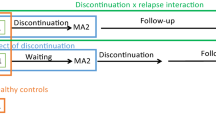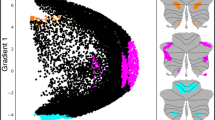Abstract
Predicting clinical response to repetitive transcranial magnetic stimulation (rTMS) in medication-resistant depression (MRD) has gained great importance in recent years. Mainly, the right subgenual anterior cingulate cortex (sgACC) functional connectivity has been put forward as biomarker in relation to rTMS clinical outcome. Even though the left and right sgACC may have different neurobiological functions, little is known about the possible lateralized predictive role of the sgACC in rTMS clinical outcome. In 43 right-handed antidepressant-free MRD patients, we applied a searchlight-based interregional covariance connectivity approach using the baseline 18FDG-PET scan—collected from two previous high-frequency (HF)-rTMS treatment studies delivering stimulation to the left dorsolateral prefrontal cortex (DLPFC)—and investigated whether unilateral or bilateral sgACC glucose metabolism at baseline would result in different predictive metabolic connectivity patterns. Regardless of sgACC lateralization, the weaker the sgACC seed-based baseline metabolic functional connections with the (left anterior) cerebellar areas, the significantly better the clinical outcome. However, the seed diameter seems to be crucial. Similar significant findings on sgACC metabolic connectivity with the left anterior cerebellum, also unrelated to sgACC lateralization, in relation to clinical outcome were observed when using the HCPex atlas. Although we could not substantiate that specifically right sgACC metabolic connectivity would predict HF-rTMS clinical outcome, our findings suggest considering the entire sgACC in functional connectivity predictions. Given that the interregional covariance connectivity results were significant only when using the Beck Depression Inventory (BDI-II) and not with the Hamilton Depression Rating Scale (HDRS), our sgACC metabolic connectivity observations also suggest the possible involvement of the (left) anterior cerebellum involved in higher-order cognitive processing as part of this predictive value.


Similar content being viewed by others
Data availability
Data will be made available on reasonable request.
References
Kim HK, Blumberger DM, Fitzgerald PB, Mulsant BH, Daskalakis ZJ (2021) Antidepressant treatment outcomes in patients with and without comorbid physical or psychiatric disorders: a systematic review and meta-analysis. J Affect Disord 295:225–234
Lefaucheur JP, Aleman A, Baeken C, Benninger DH, Brunelin J, Di Lazzaro V et al (2020) Evidence-based guidelines on the therapeutic use of repetitive transcranial magnetic stimulation (rTMS): an update (2014–2018). Clin Neurophysiol 131:474–528
Baeken C, Brem AK, Arns M, Brunoni AR, Filipcic I, Ganho-Avila A et al (2019) Repetitive transcranial magnetic stimulation treatment for depressive disorders: current knowledge and future directions. Curr Opin Psychiatry 32:409–415
Fox MD, Buckner RL, White MP, Greicius MD, Pascual-Leone A (2012) Efficacy of transcranial magnetic stimulation targets for depression is related to intrinsic functional connectivity with the subgenual cingulate. Biol Psychiatry 72:595–603
Mayberg HS (2009) Targeted electrode-based modulation of neural circuits for depression. J Clin Invest 119:717–725
Hamani C, Mayberg H, Stone S, Laxton A, Haber S, Lozano AM (2011) The subcallosal cingulate gyrus in the context of major depression. Biol Psychiatry 69:301–308
Arias JA, Williams C, Raghvani R, Aghajani M, Baez S, Belzung C et al (2020) The neuroscience of sadness: a multidisciplinary synthesis and collaborative review. Neurosci Biobehav Rev 111:199–228
Baeken C, Marinazzo D, Everaert H, Wu GR, Van Hove C, Audenaert K et al (2015) The impact of accelerated HF-rTMS on the subgenual anterior cingulate cortex in refractory unipolar major depression: insights from 18FDG PET brain imaging. Brain Stimul 8:808–815
Baeken C, Marinazzo D, Wu GR, Van Schuerbeek P, De Mey J, Marchetti I et al (2014) Accelerated HF-rTMS in treatment-resistant unipolar depression: insights from subgenual anterior cingulate functional connectivity. World J Biol Psychiatry 15:286–297
Baeken C, Duprat R, Wu GR, De Raedt R, van Heeringen K (2017) Subgenual anterior cingulate-medial orbitofrontal functional connectivity in medication-resistant major depression: a neurobiological marker for accelerated intermittent theta burst stimulation treatment? Biol Psychiatry Cogn Neurosci Neuroimaging 2:556–565
Cash RFH, Cocchi L, Lv J, Fitzgerald PB, Zalesky A (2021) Functional magnetic resonance imaging-guided personalization of transcranial magnetic stimulation treatment for depression. JAMA Psychiat 78:337–339
Hajek T, Kozeny J, Kopecek M, Alda M, Hoschl C (2008) Reduced subgenual cingulate volumes in mood disorders: a meta-analysis. J Psychiatry Neurosci 33:91–99
Baeken C, Van Schuerbeek P, De Raedt R, Ramsey NF, Bossuyt A, De Mey J et al (2010) Reduced left subgenual anterior cingulate cortical activity during withdrawal-related emotions in melancholic depressed female patients. J Affect Disord 127:326–331
Connolly CG, Wu J, Ho TC, Hoeft F, Wolkowitz O, Eisendrath S et al (2013) Resting-state functional connectivity of subgenual anterior cingulate cortex in depressed adolescents. Biol Psychiatry 74:898–907
Wu GR, Baeken C (2023) Lateralized subgenual ACC metabolic connectivity patterns in refractory melancholic depression: does it matter? Cereb Cortex 33:3490–3497
Wehrl HF, Hossain M, Lankes K, Liu CC, Bezrukov I, Martirosian P et al (2013) Simultaneous PET-MRI reveals brain function in activated and resting state on metabolic, hemodynamic and multiple temporal scales. Nat Med 19:1184–1189
Sheehan DV, Lecrubier Y, Sheehan KH, Amorim P, Janavs J, Weiller E et al (1998) The Mini-International Neuropsychiatric Interview (M.I.N.I.): the development and validation of a structured diagnostic psychiatric interview for DSM-IV and ICD-10. J Clin Psychiatry 59(Suppl 20):22–33
Rush AJ, Thase ME, Dube S (2003) Research issues in the study of difficult-to-treat depression. Biol Psychiatry 53:743–753
Hamilton M (1967) Development of a rating scale for primary depressive illness. Br J Soc Clin Psychol 6:278–296
Beck AT, Steer RA, Brown GK (1996) Beck depression inventory (BDI-II): Pearson London
Peleman K, Van Schuerbeek P, Luypaert R, Stadnik T, De Raedt R, De Mey J et al (2010) Using 3D-MRI to localize the dorsolateral prefrontal cortex in TMS research. World J Biol Psychiatry 11:425–430
Baeken C, De Raedt R, Van Hove C, Clerinx P, De Mey J, Bossuyt A (2009) HF-rTMS treatment in medication-resistant melancholic depression: results from 18FDG-PET brain imaging. CNS Spectr 14:439–448
Baeken C, Vanderhasselt MA, Remue J, Herremans S, Vanderbruggen N, Zeeuws D et al (2013) Intensive HF-rTMS treatment in refractory medication-resistant unipolar depressed patients. J Affect Disord 151:625–631
Wu GR, Baeken C (2017) Longer depressive episode duration negatively influences HF-rTMS treatment response: a cerebellar metabolic deficiency? Brain Imaging Behav 11:8–16
Wee CY, Yap PT, Shen D, Alzheimer’s Disease Neuroimaging I (2013) Prediction of Alzheimer’s disease and mild cognitive impairment using cortical morphological patterns. Hum Brain Mapp 34:3411–3425
Wu GR, Baeken C (2022) Individual interregional perfusion between the left dorsolateral prefrontal cortex stimulation targets and the subgenual anterior cortex predicts response and remission to aiTBS treatment in medication-resistant depression: the influence of behavioral inhibition. Brain Stimul 15:182–189
Cisler JM, James GA, Tripathi S, Mletzko T, Heim C, Hu XP et al (2013) Differential functional connectivity within an emotion regulation neural network among individuals resilient and susceptible to the depressogenic effects of early life stress. Psychol Med 43:507–518
Huang CC, Rolls ET, Feng J, Lin CP (2022) An extended Human Connectome Project multimodal parcellation atlas of the human cortex and subcortical areas. Brain Struct Funct 227:763–778
Chen G, Saad ZS, Britton JC, Pine DS, Cox RW (2013) Linear mixed-effects modeling approach to FMRI group analysis. Neuroimage 73:176–190
Chumbley J, Worsley K, Flandin G, Friston K (2010) Topological FDR for neuroimaging. Neuroimage 49:3057–3064
Chen L, Hudaib AR, Hoy KE, Fitzgerald PB (2020) Efficacy, efficiency and safety of high-frequency repetitive transcranial magnetic stimulation applied more than once a day in depression: a systematic review. J Affect Disord 277:986–996
Wei Q, Ji Y, Bai T, Zu M, Guo Y, Mo Y et al (2021) Enhanced cerebro-cerebellar functional connectivity reverses cognitive impairment following electroconvulsive therapy in major depressive disorder. Brain Imaging Behav 15:798–806
Ji S, Liu B, Li Y, Chen N, Fu Y, Shi J et al (2021) Trait and state alterations in excitatory connectivity between subgenual anterior cingulate cortex and cerebellum in patients with current and remitted depression. Psychiatry Res Neuroimaging 317:111356
Depping MS, Schmitgen MM, Kubera KM, Wolf RC (2018) Cerebellar contributions to major depression. Front Psychiatry 9:634
Diedrichsen J, Balsters JH, Flavell J, Cussans E, Ramnani N (2009) A probabilistic MR atlas of the human cerebellum. Neuroimage 46:39–46
Carter JD, Frampton CM, Mulder RT, Luty SE, Joyce PR (2010) The relationship of demographic, clinical, cognitive and personality variables to the discrepancy between self and clinician rated depression. J Affect Disord 124:202–206
Vanderhasselt MA, De Raedt R, Leyman L, Baeken C (2009) Acute effects of repetitive transcranial magnetic stimulation on attentional control are related to antidepressant outcomes. J Psychiatry Neurosci 34:119–126
Martin DM, McClintock SM, Forster JJ, Lo TY, Loo CK (2017) Cognitive enhancing effects of rTMS administered to the prefrontal cortex in patients with depression: a systematic review and meta-analysis of individual task effects. Depress Anxiety 34:1029–1039
Hopman HJ, Chan SMS, Chu WCW, Lu H, Tse CY, Chau SWH et al (2021) Personalized prediction of transcranial magnetic stimulation clinical response in patients with treatment-refractory depression using neuroimaging biomarkers and machine learning. J Affect Disord 290:261–271
Buckner RL, Krienen FM, Castellanos A, Diaz JC, Yeo BT (2011) The organization of the human cerebellum estimated by intrinsic functional connectivity. J Neurophysiol 106:2322–2345
Acknowledgements
This work was supported by the National Natural Science Foundation of China (Grant No. 62271415, 61876156). This work was also supported by the Queen Elisabeth Medical Foundation for Neurosciences, by the Ghent University Multidisciplinary Research Partnership “The integrative neuroscience of behavioral control”, a Grant BOF16/GOA/017 for a Concerted Research Action of Ghent University, and by an Applied Biomedical (TBM) grant of the Agency for Innovation through Science and Technology (IWT), part of the Research Foundation—Flanders (FWO) PrevenD Project 2.0 (T000720N) and FWO project G011018N.
Author information
Authors and Affiliations
Corresponding author
Ethics declarations
Conflict of interest
None to report.
Supplementary Information
Below is the link to the electronic supplementary material.
Rights and permissions
Springer Nature or its licensor (e.g. a society or other partner) holds exclusive rights to this article under a publishing agreement with the author(s) or other rightsholder(s); author self-archiving of the accepted manuscript version of this article is solely governed by the terms of such publishing agreement and applicable law.
About this article
Cite this article
Wu, GR., Baeken, C. Precision targeting in prediction for rTMS clinical outcome in depression: what about sgACC lateralization, metabolic connectivity, and the potential role of the cerebellum?. Eur Arch Psychiatry Clin Neurosci 273, 1443–1450 (2023). https://doi.org/10.1007/s00406-023-01637-3
Received:
Accepted:
Published:
Issue Date:
DOI: https://doi.org/10.1007/s00406-023-01637-3




